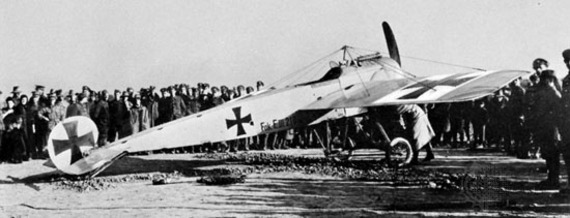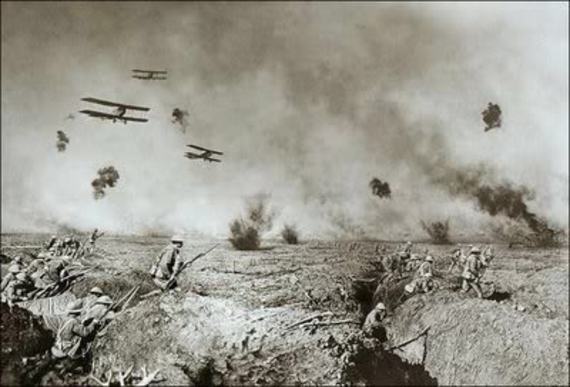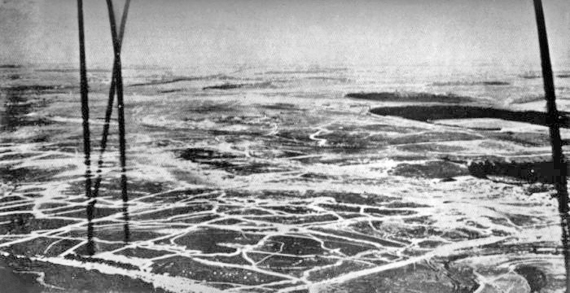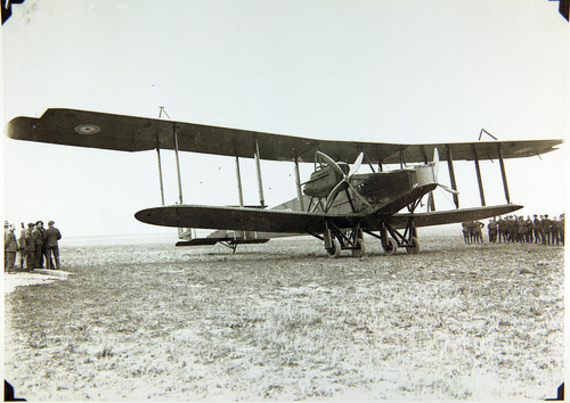Air Power in World War I: The Planes
It was the image of swopping, diving, machine-gunning aircraft that summed up the popular perception of air warfare during World War I. For the participants, the reality wasn't quite so adventurous; it was a matter of life and death. Without a parachute, if the airplane was set on fire or damaged, the pilot had only two options; stay in the plane and hope he could land it safely or take his chances and jump.
Despite the technical advances in aircraft design and performance, fighter pilots were often being sent into battle with as little as 20 hours of flying time under their belts. In the Somme valley, pilots on both sides were undertaking the dangerous task of trench strafing; typically with no prior training and rarely any practice. As the war dragged on, both sides developed more robust defenses against aerial attack, and these missions became even more perilous.

Fokker E 1 Eindecker
In July 1915, Germany overtook the Allies in air superiority by introducing the Fokker E I "Eindecker" monoplane and initiating an era known as the Fokker Scourge. The Allies hit back with new machines, including the British FE2b and DH2 and the French Nieuport 11, and, over the course of the subsequent year, won back air superiority in time for the Battle of the Somme in July 1916.
Fed by a 47, or larger, 97-round drum magazine, the American designed, Lewis light machine gun was often provided as a weapon for the rear seat gunner in Britain's Royal Flying Corps machines. With a cyclic rate of fire between 500 and 600 rounds per minute, the gun was mounted on a scarff ring around the sides and back of his cockpit. This allowed the weapon to be rapidly trained on a target. The ring could be elevated so that the gunner didn't shoot off his own tail.
The use of the airplane in the ground attack role came early on in the war. Initially small, improvised bombs were used. As the war progressed and aircraft grew larger and more powerful, the weight of the bombs that could be carried also increased. Initially, bomb loads consisted of artillery shells and exploding steel darts. These were carried within the fuselage and dropped by hand. Later on, single-engine warplanes carried a number of 20-pound bombs mounted on racks below the fuselage. The narrow trench lines and the nests of machine gun and anti-aircraft artillery made for a difficult target. Further behind the lines, however, enemy transports and troop concentrations provided easier pickings.
In late 1915 came the first flight of the Junkers J1 monoplane, an all-metal aircraft that showed the way forward for aviation technology. Shortly thereafter, the Allies introduced the Handley-Page HP O/400, the first two-engine bomber.
This was a huge machine with a maximum takeoff weight of over 13,300 pounds. It could carry up to 2,000 pounds of bombs out to a range of 700 miles. Over 500 HP O/400s were built from December 1915 onwards. The individual weight of bombs had by now risen from 50 pounds to 500 pounds.
In turn the Germans used their Gotha heavy bombers to replace their Zeppelins. In the last year of the war the Allies used heavy bombers in a tactical role to support the Argonne Offensive. During the campaign the "heavies" struck at German supply lines and troop concentrations.
The emergence of air power as a theater of conflict in World War I represented an unprecedented expansion of the battlefield into a third dimension. Not only was the conflict a world war that encompassed 90 percent of its inhabitants, but it was also a conflict that was fought out everywhere, on land and sea, beneath the waves and in the air.
Air power represented the cutting edge of industrial and technological innovation in the early twentieth century, and evolved rapidly following the first successful air flight of the Wright brothers. On the other hand, however intriguing and fascinating, it is hard to see how air power in itself was that crucial a factor in shaping the outcome of the war. Unlike the submarine or the tank, both also important technological innovations that emerged from the war and whose impact on the outcome of the war is far more apparent, we cannot point to any battles whose outcome was shaped by the role of air power.
Those daring young men and their flying machines may have captured the public's imagination and they may have been a useful tool for reconnaissance and the ground support of troops, but in the end their impact in shaping both the conduct and the outcome of the war was muted.
Instead it would be fair to say that World War I was the crucible in which the weapon of airpower was tested and refined. Many of the roles that would eventually be assumed by air power: air superiority, close ground support, strategic bombing and marine reconnaissance, first emerged during this war. So too did naval air power and the first aircraft carriers and the role of air power in shaping war at sea. It would take another generation and another world war before the true power of this weapon would be unleashed and when it was, it would prove to be devastating.





